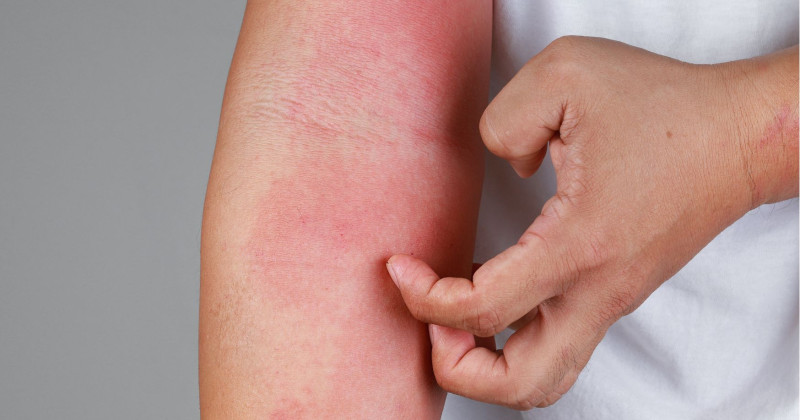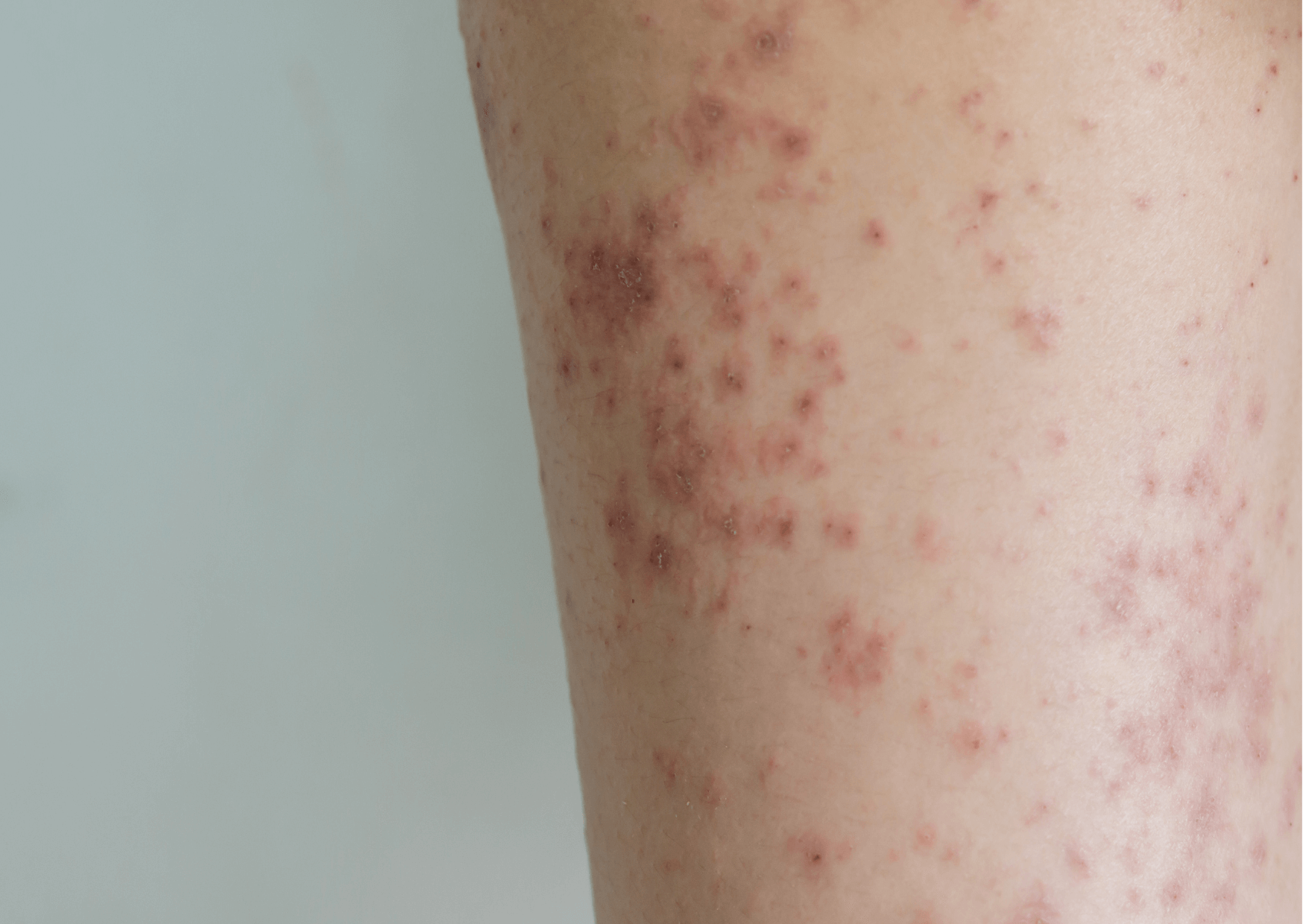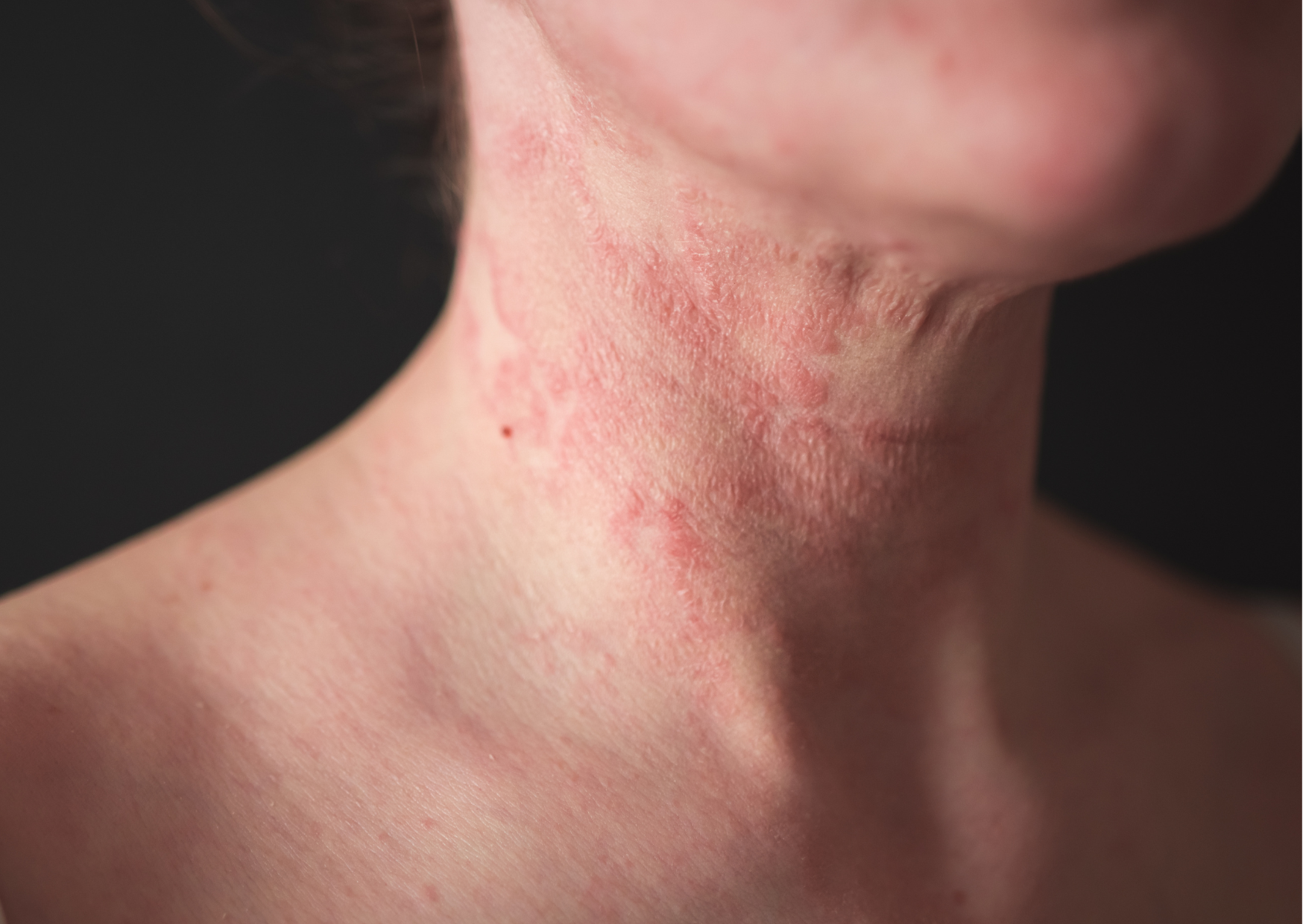What causes dermatitis and how to alleviate symptoms?

Dermatitis is an inflammatory skin disease characterized by scaly, itchy, dry, and irritated skin that can occur on both the face and body. It is estimated that one in 12 adults has atopic dermatitis.
Our skin, like our gut, has its microflora. When the microbial community is altered compared to its normal state, it creates the potential for the development of various skin disorders or diseases. Damaged skin microflora often leads to skin changes such as acne, dermatitis, and psoriasis.
In this paper, we want to focus on the problem of dermatitis, because, despite advances in treatment, many patients seek alternative solutions, especially when standard treatments are ineffective or have unwanted side effects.
Table of Contents:
General tips for relieving dermatitis
What is dermatitis?
Dermatitis or eczema is a skin condition characterized by inflammation, redness, and itching. The most common types of dermatitis are atopic and contact dermatitis. The skin becomes dry and can often become painful and cracked. The intensity of the symptoms ranges from almost non-intrusive rashes to painful blistering.

It most commonly occurs locally on the hands, back of the knees, inside of the elbows, face, and scalp, but can also affect the whole body.
What types of dermatitis are there?
The most common types include:
1. Atopic dermatitis
Atopic dermatitis or atopic eczema is a chronic inflammatory skin disease. It can occur at any age. It often develops in childhood and is inherited. It is accompanied by red, dry, and flushed skin.
2. Contact dermatitis
Contact dermatitis is caused by direct skin contact with a substance that causes an allergic reaction or irritation. Large rashes and blisters may develop from irritated skin.
3. Dishidrotic dermatitis
This form of dermatitis is characterized by a sudden outbreak of redness, peeling of the skin, and the appearance of blisters, especially on the palms of the hands and soles of the feet. It can affect people of any age but is most common after the age of 40. The cause is not fully understood.
4. Seborrhoeic dermatitis
Seborrhoeic dermatitis is a chronic inflammatory skin disease characterized by white-yellow scales. The latter occurs mainly on the face and chest.
In addition, there are also:
- neurodermatitis (itchy areas of the skin that can be caused by increased stress),
- nummular dermatitis (round inflammatory rashes that may appear after an injury to the skin),
- static dermatitis (characterized by changes in the skin as a result of poor blood circulation),
- dermatitis neglect (occurring as a result of poor hygiene).
Atopic dermatitis
Atopic dermatitis is an inflammatory skin disease characterized by scaly, itchy, dry, and irritated skin that can occur on both the face and the body. It occurs most commonly in infants and children, but less frequently in adulthood. It is estimated that one in 12 adults has atopic dermatitis.
Atopic dermatitis can occur anywhere on the body, but the most common areas are the face (including around the eyes), neck and décolletage, scalp, elbows, knees, hands, and feet.

In fair-skinned people, the affected area of skin is usually red and may turn brown. In darker-skinned people, the affected skin may become lighter or darker as atopic dermatitis affects pigmentation.
Atopic skin is characterized by two phases: an acute phase also called the ''flare-up phase'', and a non-acute phase. The latter deals with the period between flare-ups, when atopic skin is calmer and less irritable.
What causes dermatitis?
Dermatitis is associated with impaired skin barrier function and immune system dysfunction. This is because when the skin's natural barrier function is impaired, the skin is more susceptible to irritation and infection.
Individuals with atopic dermatitis have been found to have an increase in Staphylococcus aureus bacteria and reduced microbial diversity in the skin microbiome.
Damaged skin microbiota may result:
- genetic factors
- climate and pollution
- the use of aggressive skin care products,
- too frequent exfoliation,
- UV damage
How does diet affect dermatitis?
Many studies have confirmed that food can cause dermatitis, which flares up within 2 to 24 hours after eating a certain food. In most cases, food is the cause of the exacerbation of dermatitis, but not of its onset.
Certain foods are more commonly associated with outbreaks of eczema. The following are often considered common allergens:
- Cow's milk,
- eggs,
- gluten,
- nuts,
- fish and shellfish.
Other foods such as tomatoes, citrus fruits, and certain spices can also cause a reaction. We also recommend that you consult your doctor or dermatologist, who may refer you for an allergy test.
Which foods can help reduce the symptoms of dermatitis?
1. Probiotics
There is evidence to suggest that a healthy immune system will help improve your overall health and affect your skin. A healthy digestive system with a diverse range of good bacteria in the gut can help boost your immune system.

Add foods such as yogurt, kefir, sauerkraut, miso, sourdough bread, and kombucha to your menu.
It has been shown that eating probiotic foods to improve gut bacteria can be effective in fighting dermatitis. There are many probiotic supplements available, but adding probiotic foods to your diet is also beneficial.
2. Eat fibre-rich foods
Fibre is one of those nutrients in our diet that is extremely important. They maintain gut and gastrointestinal health and are linked by experts to the prevention of many modern diseases such as cardiovascular disease, diabetes, colon cancer, obesity, and various inflammatory skin processes.
Fibre-rich foods include whole grains, oats, chia seeds, lentils, chickpeas, and fresh fruit and vegetables.
Some patients report that their dermatitis decreased or disappeared completely after increasing their daily intake of fruit and vegetables. In addition to being rich in fiber, fruit and vegetables contain carotenoids, flavonoids, vitamins, and minerals that reduce oxidative stress and inflammatory cytokines.
3. Increase zinc intake
Zinc is particularly beneficial for many skin diseases. Zinc deficiency often manifests itself in the skin and hair in the form of rough skin, slower wound healing, and various skin lesions (dermatitis, psoriasis, alopecia, skin pigmentation disorders).

Natural sources of zinc are red meat, dark chocolate, seafood, and pumpkin seeds. You can also find zinc in our dietary supplement Collagen shot.
How to reduce the chances of dermatitis?
As there is no cure for atopic dermatitis, the best way to take care of your skin is to do everything you can to reduce the chances of an outbreak. In addition to dietary changes, some people have found the following to help:
1. Pay attention to the temperature of the water
Frequent washing in water that is too hot can damage the skin's protective barrier and cause it to dry out. Coarse sponges and massage brushes can put a strain on atopic skin.
Wash with lukewarm water, limit bathing time, and preferably shower and rinse your skin rather than scrubbing it with a towel. Take a quick shower as soon as possible after exercise to cool the body and remove sweat - heat, and sweat can trigger a flare-up in some people.
If you need to wash your hands frequently at work or if your hands are exposed to strong chemicals, try to limit your exposure.
2. Protect yourself from the sun
Sun protection is also a must for those of you who do not suffer from dermatitis. It protects us from harmful ultraviolet rays that can cause premature skin aging and damage our DNA and lipids.
Atopic skin is already dry, but the sun makes it even drier. Limit your exposure to the sun, avoid the hours when the sun is at its most intense, protect yourself with clothing, and apply sunscreen with an appropriate SPF.
3. Wear soft, breathable clothing
Try to avoid coarse and synthetic fabrics on the skin. Wool can also cause itching in some people. Some washing detergents can trigger an atopic skin reaction, so choose non-biological products that are kind to sensitive skin.
4. Make-up
Choose products that have been specifically designed for dry and sensitive skin to reduce the chances of irritation.
5. Try to reduce stress
Relaxation exercises such as yoga and meditation can help reduce stress, which is often cited as a trigger for atopic skin, especially in women.
